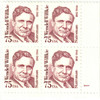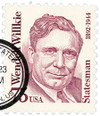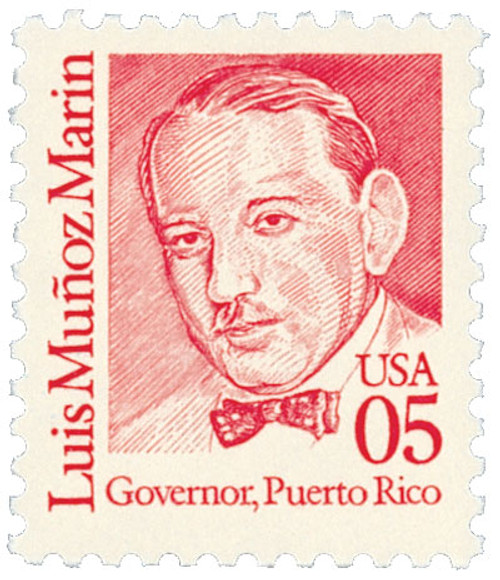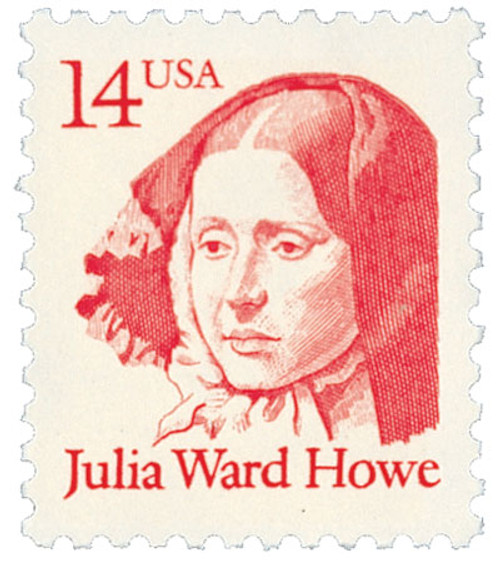
# 2192 - 1992 75c Great Americans: Wendell Willkie
US #2192
1992 Wendell Willkie
- Honors statesman Wendell Willkie
- 51st stamp in the Great Americans Series
- Issued in honor of Willkie’s 100th birth anniversary
Category of Stamp: Definitive
Set: Great Americans
Value: 75¢, Triple-Weight First-Class rate
First Day of Issue: February 16, 1992
First Day City: Bloomington, Indiana
Quantity Issued: 161,080,000
Printed by: Bureau of Engraving and Printing
Printing Method/Format: Intaglio engraved (Printing sleeves of 800 subjects – 20 across, 40 down, separated into panes of 100)
Perforations: 11
Color: Deep magenta
Reason the stamp was issued: The Willkie stamp honors the 1940 Republican presidential candidate, author, and statesman.
About the stamp design: The style of this stamp is similar to others in the Great Americans series. Its image of Willkie was done by Christopher Calle, the artist behind over 30 US stamps, including #2419, honoring the 20th anniversary of Apollo 11’s moon landing. Calle used a 1940 campaign photo of Willkie as inspiration for his pencil drawing used on the stamp.
Special design details: The color used for the stamp pays tribute to Indiana University’s official color. Willkie graduated from the University’s law school.
First Day City: The Willkie stamp was revealed in Bloomington, Indiana, home of Indiana University, the statesman’s alma mater. The ceremony was part of a three-day celebration of Willkie’s 100th birth anniversary.
About the Great Americans Series: The Great Americans Series was created to replace the Americana Series. The new series would be characterized by a standard definitive size, simple design, and monochromatic colors.
This simple design included a portrait, “USA,” the denomination, the person’s name, and in some cases, their occupation or reason for recognition. The first stamp in the new series was issued on December 27, 1980. It honored Sequoyah and fulfilled the new international postcard rate that would go into effect in January 1981.
The Great Americans Series would honor a wider range of people than the previous Prominent Americans and Liberty Series. While those series mainly honored presidents and politicians, the Great Americans Series featured people from many fields and ethnicities. They were individuals who were leaders in education, the military, literature, the arts, and human and civil rights. Plus, while the previous series only honored a few women, the Great Americans featured 15 women. This was also the first definitive series to honor Native Americans, with five stamps.
The Bureau of Engraving and Printing (BEP) produced most of the stamps, but private firms printed some. Several stamps saw multiple printings. The result was many different varieties, with tagging being the key to understanding them. Though there were also differences in perforations, gum, paper, and ink color.
The final stamp in the series was issued on July 17, 1999, honoring Justin S. Morrill. Spanning 20 years, the Great Americans was the longest-running US definitive series. It was also the largest series of face-different stamps, with a total of 63.
History the stamp represents: Lewis Wendell Willkie (1892-1944) graduated from Indiana School of Law in 1916. He put his law career on hold when he volunteered for the US Army during World War I. After the war, he opened a law practice and worked with utility companies. He opposed President Franklin Roosevelt’s Tennessee Valley Authority, arguing it would put the government in control of the nation’s electrical supply. Though he lost the fight, Willkie became nationally known.
Because Willkie was opposed to the direction the Democratic party was headed, he switched his party affiliation to Republican. In 1940, he won his new party’s presidential nomination. He lost to FDR in a close election. Willkie’s views on international cooperation caught the attention of the President. FDR asked Willkie to tour the world in support of those fighting fascism.
In 1943, Willkie published the best-seller One World. This influential book made a convincing argument for post-World War II international cooperation. Willkie proposed the US could not oppose colonialism until it ended its colonial attitudes towards its minorities, especially blacks. One World solidified Willkie’s influence in American politics. In 1944, he again attempted to gain the Republican nomination for president, but failed. He died of a heart attack on October 4 of that year. President Roosevelt called Willkie “a godsend to this country when we needed him most.” Though he never held a public office and was a public figure for less than five years, Wendell Willkie contributed to global cooperation in an unprecedented way.
US #2192
1992 Wendell Willkie
- Honors statesman Wendell Willkie
- 51st stamp in the Great Americans Series
- Issued in honor of Willkie’s 100th birth anniversary
Category of Stamp: Definitive
Set: Great Americans
Value: 75¢, Triple-Weight First-Class rate
First Day of Issue: February 16, 1992
First Day City: Bloomington, Indiana
Quantity Issued: 161,080,000
Printed by: Bureau of Engraving and Printing
Printing Method/Format: Intaglio engraved (Printing sleeves of 800 subjects – 20 across, 40 down, separated into panes of 100)
Perforations: 11
Color: Deep magenta
Reason the stamp was issued: The Willkie stamp honors the 1940 Republican presidential candidate, author, and statesman.
About the stamp design: The style of this stamp is similar to others in the Great Americans series. Its image of Willkie was done by Christopher Calle, the artist behind over 30 US stamps, including #2419, honoring the 20th anniversary of Apollo 11’s moon landing. Calle used a 1940 campaign photo of Willkie as inspiration for his pencil drawing used on the stamp.
Special design details: The color used for the stamp pays tribute to Indiana University’s official color. Willkie graduated from the University’s law school.
First Day City: The Willkie stamp was revealed in Bloomington, Indiana, home of Indiana University, the statesman’s alma mater. The ceremony was part of a three-day celebration of Willkie’s 100th birth anniversary.
About the Great Americans Series: The Great Americans Series was created to replace the Americana Series. The new series would be characterized by a standard definitive size, simple design, and monochromatic colors.
This simple design included a portrait, “USA,” the denomination, the person’s name, and in some cases, their occupation or reason for recognition. The first stamp in the new series was issued on December 27, 1980. It honored Sequoyah and fulfilled the new international postcard rate that would go into effect in January 1981.
The Great Americans Series would honor a wider range of people than the previous Prominent Americans and Liberty Series. While those series mainly honored presidents and politicians, the Great Americans Series featured people from many fields and ethnicities. They were individuals who were leaders in education, the military, literature, the arts, and human and civil rights. Plus, while the previous series only honored a few women, the Great Americans featured 15 women. This was also the first definitive series to honor Native Americans, with five stamps.
The Bureau of Engraving and Printing (BEP) produced most of the stamps, but private firms printed some. Several stamps saw multiple printings. The result was many different varieties, with tagging being the key to understanding them. Though there were also differences in perforations, gum, paper, and ink color.
The final stamp in the series was issued on July 17, 1999, honoring Justin S. Morrill. Spanning 20 years, the Great Americans was the longest-running US definitive series. It was also the largest series of face-different stamps, with a total of 63.
History the stamp represents: Lewis Wendell Willkie (1892-1944) graduated from Indiana School of Law in 1916. He put his law career on hold when he volunteered for the US Army during World War I. After the war, he opened a law practice and worked with utility companies. He opposed President Franklin Roosevelt’s Tennessee Valley Authority, arguing it would put the government in control of the nation’s electrical supply. Though he lost the fight, Willkie became nationally known.
Because Willkie was opposed to the direction the Democratic party was headed, he switched his party affiliation to Republican. In 1940, he won his new party’s presidential nomination. He lost to FDR in a close election. Willkie’s views on international cooperation caught the attention of the President. FDR asked Willkie to tour the world in support of those fighting fascism.
In 1943, Willkie published the best-seller One World. This influential book made a convincing argument for post-World War II international cooperation. Willkie proposed the US could not oppose colonialism until it ended its colonial attitudes towards its minorities, especially blacks. One World solidified Willkie’s influence in American politics. In 1944, he again attempted to gain the Republican nomination for president, but failed. He died of a heart attack on October 4 of that year. President Roosevelt called Willkie “a godsend to this country when we needed him most.” Though he never held a public office and was a public figure for less than five years, Wendell Willkie contributed to global cooperation in an unprecedented way.






















